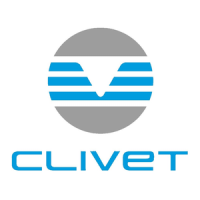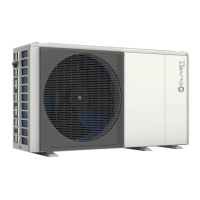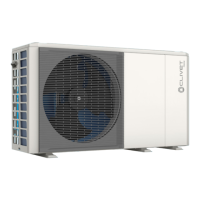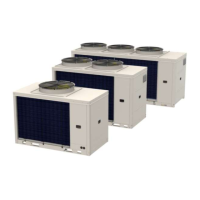159
Serviceman warnings
11.15 Removal and evacuation
When the refrigerant circuit needs to be repaired or for other purposes, conventional procedures can be
followed. However, it is important to follow recommended practices taking flammability hazards into account.
The following procedure is recommended:
• extract the refrigerant;
• purge the circuit with inert gas;
• evacuate;
• purge again using inert gas;
• open the circuit by cutting or brazing.
The refrigerant charge can be recovered in the appropriate cylinders. The system must be purged with oxy-
gen-free nitrogen to make the unit safe. It may be necessary to repeat this procedure several times. Do not
use compressed air or oxygen for this operation.
Purging can be performed by introducing oxygen-free nitrogen into the vacuum circuit in the system and
continuing to fill until operating pressure is reached, then venting into the atmosphere and recreating the
vacuum. This procedure must be repeated until the refrigerant is completely removed from the system.
When the last OFN charge is introduced, the system must be vented to atmospheric pressure to allow work
to be performed. This operation is absolutely essential if brazing operations are to be carried out on the
piping.
Check that the output for the vacuum pump is not closed for any ignition source and that good ventilation
is available.
11.16 Charging operations
In addition to conventional charging procedures, it is recommended to follow the ensuing guidelines:
• When using charging equipment, avoid contamination with dierent refrigerants.
• Cylinders must be held vertically.
• Before charging the refrigerant into the system, make sure that it is properly earthed.
• Label the system after loading (if the label is not already present).
• Use extreme care to avoid overfilling or underfilling the system.
• Before recharging the system, test the pressure using oxygen-free nitrogen. After charging, but before
start-up, check the system for leaks. Perform an additional leakage check before leaving the site.
11.17 Disposal
Before performing this procedure, it is essential that the technician is fully familiar with the equipment and all
of its components. It is recommended to recover all refrigerants following safe procedures. Before proceed-
ing, take an oil and refrigerant sample.
Before reusing the recovered refrigerant, it should be analysed if necessary. Before starting the procedure
it is essential to check the availability of the power supply.
• Familiarise yourself with the device and its operation.
• Electrically isolate the system.
• Before proceeding, check the following:
• that mechanical equipment for handling refrigerant cylinders is available if necessary;
• that the necessary personal protective equipment is available and is used;
• that the recovery process is carried out under the constant supervision of a competent person;
• that the recovery equipment and cylinders comply with regulations in force.
• If possible, transfer the refrigerant to the unit using a “pump-down” procedure.
• If it is not possible to create a vacuum, use a manifold that allows the refrigerant to be expelled from var-
ious parts of the system.
• Before proceeding with the recovery, place the cylinder on the scales.
• Start the recovery device and use it according to the manufacturer's instructions.
• Do not fill the cylinders excessively. (Do not exceed 80% of the liquid volume).
• Do not exceed the maximum working pressure of the cylinder, even temporarily.
• After filling the cylinders correctly and completing the procedure, transfer the cylinders and equipment
from the site as soon as possible and close all isolation valves on the equipment.
• Before loading the recovered refrigerant into another refrigeration system it will be necessary to clean

